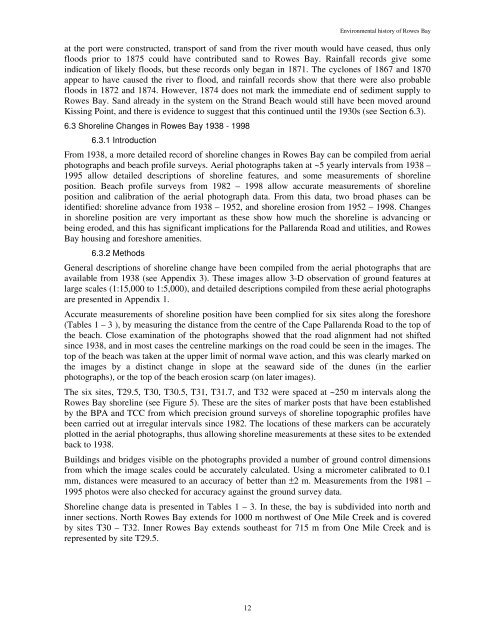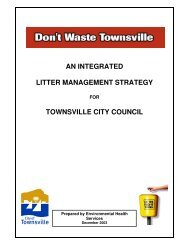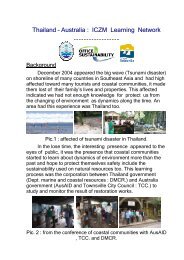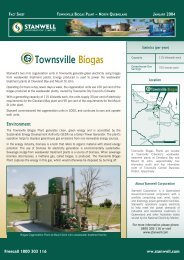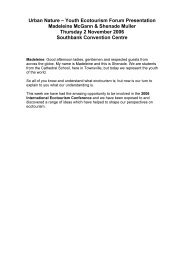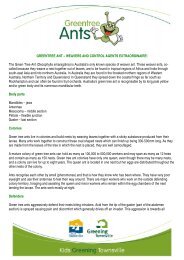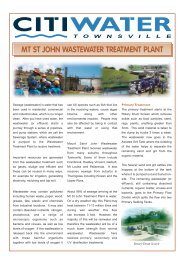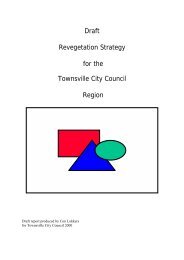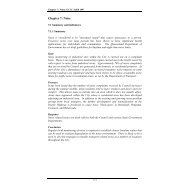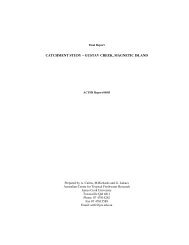ENVI RONMENTAL HI STORY OF ROWES BAY - Townsville State ...
ENVI RONMENTAL HI STORY OF ROWES BAY - Townsville State ...
ENVI RONMENTAL HI STORY OF ROWES BAY - Townsville State ...
- No tags were found...
Create successful ePaper yourself
Turn your PDF publications into a flip-book with our unique Google optimized e-Paper software.
Environmental history of Rowes Bayat the port were constructed, transport of sand from the river mouth would have ceased, thus onlyfloods prior to 1875 could have contributed sand to Rowes Bay. Rainfall records give someindication of likely floods, but these records only began in 1871. The cyclones of 1867 and 1870appear to have caused the river to flood, and rainfall records show that there were also probablefloods in 1872 and 1874. However, 1874 does not mark the immediate end of sediment supply toRowes Bay. Sand already in the system on the Strand Beach would still have been moved aroundKissing Point, and there is evidence to suggest that this continued until the 1930s (see Section 6.3).6.3 Shoreline Changes in Rowes Bay 1938 - 19986.3.1 IntroductionFrom 1938, a more detailed record of shoreline changes in Rowes Bay can be compiled from aerialphotographs and beach profile surveys. Aerial photographs taken at ~5 yearly intervals from 1938 –1995 allow detailed descriptions of shoreline features, and some measurements of shorelineposition. Beach profile surveys from 1982 – 1998 allow accurate measurements of shorelineposition and calibration of the aerial photograph data. From this data, two broad phases can beidentified: shoreline advance from 1938 – 1952, and shoreline erosion from 1952 – 1998. Changesin shoreline position are very important as these show how much the shoreline is advancing orbeing eroded, and this has significant implications for the Pallarenda Road and utilities, and RowesBay housing and foreshore amenities.6.3.2 MethodsGeneral descriptions of shoreline change have been compiled from the aerial photographs that areavailable from 1938 (see Appendix 3). These images allow 3-D observation of ground features atlarge scales (1:15,000 to 1:5,000), and detailed descriptions compiled from these aerial photographsare presented in Appendix 1.Accurate measurements of shoreline position have been complied for six sites along the foreshore(Tables 1 – 3 ), by measuring the distance from the centre of the Cape Pallarenda Road to the top ofthe beach. Close examination of the photographs showed that the road alignment had not shiftedsince 1938, and in most cases the centreline markings on the road could be seen in the images. Thetop of the beach was taken at the upper limit of normal wave action, and this was clearly marked onthe images by a distinct change in slope at the seaward side of the dunes (in the earlierphotographs), or the top of the beach erosion scarp (on later images).The six sites, T29.5, T30, T30.5, T31, T31.7, and T32 were spaced at ~250 m intervals along theRowes Bay shoreline (see Figure 5). These are the sites of marker posts that have been establishedby the BPA and TCC from which precision ground surveys of shoreline topographic profiles havebeen carried out at irregular intervals since 1982. The locations of these markers can be accuratelyplotted in the aerial photographs, thus allowing shoreline measurements at these sites to be extendedback to 1938.Buildings and bridges visible on the photographs provided a number of ground control dimensionsfrom which the image scales could be accurately calculated. Using a micrometer calibrated to 0.1mm, distances were measured to an accuracy of better than ±2 m. Measurements from the 1981 –1995 photos were also checked for accuracy against the ground survey data.Shoreline change data is presented in Tables 1 – 3. In these, the bay is subdivided into north andinner sections. North Rowes Bay extends for 1000 m northwest of One Mile Creek and is coveredby sites T30 – T32. Inner Rowes Bay extends southeast for 715 m from One Mile Creek and isrepresented by site T29.5.12


